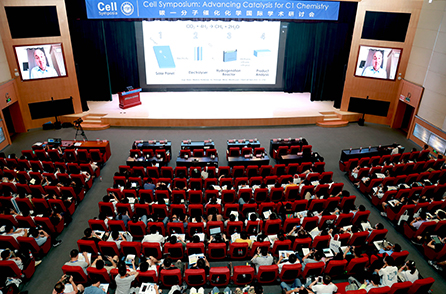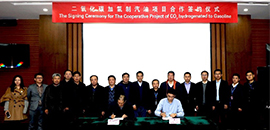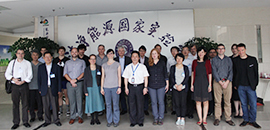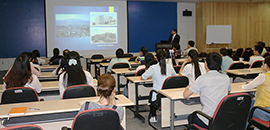News Updates
-
 07 30, 2021Cell Symposium: Advancing Catalysis for C1 Chemistry held in ChinaThe 2021 Cell Symposium: Advancing Catalysis for C1 Chemistry, with the theme of "Frontiers in the Catalytic Conversion of C1 Molecules," was held in Dalian, China from July 23 to July 25. It was cosponsored by Cell Press and the Dalian Institute of Chemical Physics (DICP) of the Chinese Academy of Sciences (CAS).
07 30, 2021Cell Symposium: Advancing Catalysis for C1 Chemistry held in ChinaThe 2021 Cell Symposium: Advancing Catalysis for C1 Chemistry, with the theme of "Frontiers in the Catalytic Conversion of C1 Molecules," was held in Dalian, China from July 23 to July 25. It was cosponsored by Cell Press and the Dalian Institute of Chemical Physics (DICP) of the Chinese Academy of Sciences (CAS).
The 2021 Cell Symposium: Advancing Catalysis for C1 Chemistry, with the theme of "Frontiers in the Catalytic Conversion of C1 Molecules," was held in Dalian, China from July 23 to July 25. It was cosponsored by Cell Press and the Dalian Institute of Chemical Physics (DICP) of the Chinese Academy of Sciences (CAS).
The program consisted of nine plenary sessions and five keynote speeches, as well as approximately 80 invited reports, 70 short talks, and 60 flash talks. Close to 100 posters were set up of which eight received the Cell Symposium Excellent Poster award. The opening ceremony was hosted by Prof. DENG Dehui of the DICP.
Prof. LIU Zhongmin, academician of the Chinese Academy of Engineering, and director of the DICP, and the Qingdao Institute of Bioenergy and Process of CAS, said in his opening speech that the global energy industry today is undergoing comprehensive and profound changes. In the transformation of the global energy industry toward a sustainable society, the catalytic conversion of C1 molecules represented by methane, methanol, carbon monoxide, and carbon dioxide will play an important role and the advanced catalysis technologies centered on C1 chemistry will provide key support in these processes.
The symposia invited internationally renowned scholars to present the plenaries, including Prof. BAO Xinhe and Prof. LIU Zhongmin from DICP, Prof. HAN Buxing from the Institute of Chemistry of CAS, Prof. WU Lizhu from the Technical Institute of Physics and Chemistry of CAS, Prof. Christophe Copéret from ETH Zurich, Switzerland, Prof. Bert Weckhuysen from the University of Utrecht, the Netherlands, Prof. Emiel Hensen from Eindhoven University of Technology, the Netherlands, Prof. Edward Sargent from the University of Toronto, Canada, and Prof. Núria López from the Institute of Chemical Research of Catalonia, Spain. More than 500 experts and scholars attended the meeting either offline or online.
With the goal of promoting collaboration and idea-sharing, the symposium also held a youth forum on catalysis and invited outstanding young scientists to participate in interdisciplinary exchanges and discussions. This symposium provided a high-level communication platform for scientific researchers in the field of C1 chemistry. The participating experts and scholars conducted in-depth exchanges and discussions on cutting-edge scientific issues and challenges in the thermocatalytic, electrocatalytic, and photocatalytic conversion of syngas, carbon dioxide, methanol, methane, and biomass. (Text and Image by GAO Hehua) -
02 25, 2020DICP Scientists published China's first international standard for flow batteriesThe first international standard for flow batteries "Flow battery energy systems for stationary applications-Part 2-1: Performance general requirements and test methods" was recently published.The first international standard for flow batteries "Flow battery energy systems for stationary applications-Part 2-1: Performance general requirements and test methods" was recently published.The standard number is IEC 62932-2-1: 2020 (https://webstore.iec.ch/ searchform & q = IEC% 2062932).This standard was jointly formulated by Dalian Institute of Chemical Physics (DICP) of the Chinses Academy of Sciences and Dalian Rongke Power Co., Ltd. under the leadership of Prof. ZHANG Huamin. It represents China’s flow battery technology has been recognized by international peers. The formulation and implementation of international standards for flow batteries will play an important role in accelerating the industrialization and enhancing its international competitiveness of China's flow battery technology. In 2014, relying on the international leading position of flow battery technology of the Energy Storage Division of DICP and Dalian Rongke Power Co., Ltd., the Technical Committee of flow battery standardization of the National Energy Administration (NEA/TC 23), with Prof. Huamin Zhang as the chairman, firstly made a proposal of formulating the international standard ‘performance general requirements and test methods of flow batteries’ to the International Electrotechnical Commission (IEC). This proposal was approved after voting by members of the International Electrotechnical Commission / Technical Committee on Secondary Batteries and Battery Packs (IEC / TC21). The joint working group (IEC / TC21 JWG7), jointed by IEC / TC21 and the Fuel Cell Technical Committee (TC105), actively promoted the progress of the international standardization formulation. The standard successively passed the new proposal (NP), working draft (WD), committee draft (CD), voting for committee draft (CDV), and the final draft of international standard (FDIS) stages and lasted nearly 6 years, was formally published recently. There are totally 3 international standards for flow batteries published for the first batch this time, and the remaining two are: “Flow battery energy systems for stationary applications-Part 1: Terminology and general aspects (IEC 62932-1: 2020) drafted by Europe and "Flow battery energy systems for stationary applications-Part 2-2 Safety requirements" (IEC 62932- 2-2: 2020)) drafted by Japan. (Text by LIU Xin)
-
 10 08, 2019DICP Holds 70th Anniversary CelebrationThe Symposium on the Development Strategy of the Dalian Institute of Chemical Physics -- the DICP -- and the 70th anniversary celebration of the founding of the institute were held on Sept 19.
10 08, 2019DICP Holds 70th Anniversary CelebrationThe Symposium on the Development Strategy of the Dalian Institute of Chemical Physics -- the DICP -- and the 70th anniversary celebration of the founding of the institute were held on Sept 19.
The Symposium on the Development Strategy of the Dalian Institute of Chemical Physics -- the DICP -- and the 70th anniversary celebration of the founding of the institute were held on Sept 19.
Organizers said nearly 400 guests from home and abroad attended the celebration, held in Dalian in Liaoning province.
Some 13 research achievements made by scientists from the DICP were honored as “Outstanding Research Achievements in 70 Years” during the event.
Over the past seven decades, the DICP has conducted scientific research and technology development in various areas. Among the fields are catalytic chemistry, engineering chemistry, chemical lasers and molecular reaction kinetics, modern analytical chemistry and biotechnology.
Since its establishment in 1949, 20 scientists from the institute have been elected academicians of the Chinese Academy of Sciences and the Chinese Academy of Engineering. Four have been elected as academicians of The World Academy of Sciences, and one was elected as a member of the Academia Europaea, also known as the Academy of Europe.
Liu Zhongmin, director of DICP, delivered a speech at the celebration. He pointed out that through the years the institute has always adhered its philosophy: “forge ahead with innovation, make joint efforts to overcome difficulties, study rigorously and pursue the first-rate.”
Liu added that inspired and guided by that spirit, the staff of DICP always had the mission of serving the country in mind. They had inherited the excellent culture of the older generation of scientists and made their own contributions to build the DICP into a world-class research institute.
Liu and other leading figures gave reports on various topics at the Symposium on the Development Strategy of DICP in the afternoon.
The other speakers were Lu Dehong from the Research Department of the China International and Strategic Studies, Li Can from the DICP, Nick Johnstone from the International Energy Agency, He Mingyuan from East China Normal University and Liu Ke from Southern University of Science and Technology.
The DICP is the only university research institute in Liaoning province selected as a national innovation demonstration base.
Officials said that as such, it actively runs a full-chain scientific and technological results incubation and transformation service system – covering, among other things, project incubation, entrepreneurship nurseries, incubators and accelerators.
Start-ups can obtain comprehensive financial support from the DICP system, including intellectual property funds, angel funds, venture capital funds and industrial funds.
In recent years, the institute has added strong momentum to the high-quality development of the local economy through continuous upgrades of its scientific and technological mechanisms.
Officials said a series of major research achievements made by DICP scientists had been industrialized in Liaoning province, bringing local business partners an annual output value of more than 5 billion yuan ($703 million). -
 01 07, 2018Signing Ceremony for Carbon Dioxide Hydrogenated to Gasoline Cooperative Project Holds in DICPOn December 26, the signing ceremony for the cooperative project of “Carbon Dioxide Hydrogenated to Gasoline” established by Dalian Institute of Chemical Physics (DICP) of the Chinese Academy of Sciences and Beijing Psyche Energy Tech Co., Ltd. was held in DICP.
01 07, 2018Signing Ceremony for Carbon Dioxide Hydrogenated to Gasoline Cooperative Project Holds in DICPOn December 26, the signing ceremony for the cooperative project of “Carbon Dioxide Hydrogenated to Gasoline” established by Dalian Institute of Chemical Physics (DICP) of the Chinese Academy of Sciences and Beijing Psyche Energy Tech Co., Ltd. was held in DICP.
On December 26, the signing ceremony for the cooperative project of “Carbon Dioxide Hydrogenated to Gasoline” established by Dalian Institute of Chemical Physics (DICP) of the Chinese Academy of Sciences and Beijing Psyche Energy Tech Co., Ltd. was held in DICP.
The project focuses on series of works, including the scale-up of catalyst preparation process, the process package design, and the final pilot demonstration.
The successful launch of the project marks the process of “Carbon Dioxide Hydrogenated to Gasoline” has stepped from the laboratory toward industrialization, which would also be helpful to promote the development of green and low-carbon environmental protection in China and even in the world.
Signing Ceremony for the cooperative project of "Carbon Dioxide Hydrogenated to Gasoline". (Photo by LIU Wansheng)
The process of “Carbon Dioxide Hydrogenated to Gasoline” was patented technology with full independent intellectual property rights, invented by the research team led by Dr. SUN Jian and Prof. GE Qingjie in DICP.
By developing a high efficient, stable and multifunctional Na–Fe3O4/HZSM-5 catalyst, the process realizes the direct production of high-octane gasoline from CO2 hydrogenation for the first time. The process is a potential alternative clean energy strategy to fossil fuels, which not only contributes to mitigating CO2 emissions, but also reduces dependence on petrochemicals.
The process was first reported in the journal, Nature Communications (DOI: 10.1038/ncomms15174), in May 2017, and then selected as a research highlight in the journal, Nature, which has arisen worldwide concerns.
Since the breakthrough in fundamental scientific research, the team has accelerated the engineering development research of the process. A series of breakthroughs have been made in improving the stability of the catalyst, methods for catalyst preparation and the design of new reactor.
This process has accomplished an over than 1,000h of stability test experiment during which CO2 conversion and the selectivity to gasoline-range hydrocarbons remain stable, and the gasoline products are mainly C5-C11 isoparaffins and aromatics thus favoring the octane number. The work has now been applied to several Chinese patents and international PCT patents, and formed full independent intellectual property rights.
On December 19, the China’s national development and reform commission issued the construction plan of national carbon emission rights trading market (power generation industry), which marks the official launch of China's carbon trading system.
It is China's major decision making in promoting green, low-carbon and circular development. The signing of this technical cooperation contract would make contributions to realize the goal of China's control of greenhouse gas emissions, to boost green and low-carbon development and build a beautiful China, and to propel our country's efforts to tackle climate change. (Text by WEI Jian) -
 10 10, 2017The 7th Chemical Sciences and Society Summit is Held in DalianThe 7th Chemical Sciences and Society Summit (CS3)was held in Dalian on September 6th to 8th, 2017
10 10, 2017The 7th Chemical Sciences and Society Summit is Held in DalianThe 7th Chemical Sciences and Society Summit (CS3)was held in Dalian on September 6th to 8th, 2017
The 7th Chemical Sciences and Society Summit (CS3)was held in Dalian on September 6th to 8th, 2017, which was organized by the Chemical Society of China, the United States, Germany, Britain, Japan and National Natural Science Foundation of China. 2017 CS3 was focusing “Solar Energy & Photonics for a Sustainable Future”, and covering the four sub-topics: Artificial Photosynthesis and CO2 Reduction; New PV Materials with Abundant Elements; Photonic Materials and Photon Upconversion and Photofunctional Materials and Structures for Light Manipulation.
Prof. LI Can from the Dalian Institute of Chemical Physics, Chinese Academy of Sciences was the head of Chinese delegation and the scientific chair of this summit. During the three days meeting, 40 experts from China, Germany, Japan, the UK and the USA came together and discussed the issues of the sustainable future of solar energy and photonics. The results of the discussion will be condensed and summarized into a white paper.
On the 8th September, CS3 participants visited Dalian Institute of Chemical Physics, vice director Prof. JIN Yuqi met the visitors and gave the brief introduction of DICP. Then participants visited Energy Storage Division, Fuel Cell & Battery Division, Solar Energy Division and Nano and Interfacial Catalysis Group.
The CS3 initiative is a collaboration between the Chinese Chemical Society (CCS), the German Chemical Society (GDCh), the Chemical Society of Japan (CSJ), the Royal Society of Chemistry (RSC), and the American Chemical Society (ACS). The symposia series is supported by the National Science Foundation of China (NSFC), the German Research Foundation (DFG), the Japan Science and Technology Agency (JST), the UK Engineering and Physical Sciences Research Council (EPSRC), and the U.S. National Science Foundation (NSF). CS3 brings together some of the best minds in chemical research from around the world and challenges them to propose innovative solutions to society’s most pressing needs in health, food, energy, and the environment. This unique gathering boasts an innovative format, aiming to set the course of international science, and rotates among participating nations.
China is the one of initiators of CS3, and is the only representative of the developing countries, which is the proof of the improvement of the international status of basic research in chemistry of China. Taking part in this summit can help China enhance the international status in chemistry; promotes China’s young chemical scientists to enter into the research frontier; reflects Chinese’s responsibility as the super country.
Solar energy research team, led by Prof. LI Can, focuses the research on solar energy photocatalysis, photocatalytic decomposition of hydrogen in water and reduction of carbon dioxide. Over the past decade, the research team has made significant progress in the field of cutting-edge scientific research: with the strategy of dual co-catalysts loaded on semiconductor, the photocatalytic hydrogen production quantum efficient can reach up to 93%, which is the highest record in the world; new conception of phase junction promoting charge separation and photocatalytic performance was proposed; new phenomenon of charge separation between the different facets of semiconductor crystal was found; with the new conception and strategy of fabrication“hole-storage layer”on the photoelectrochemical electrode for water splitting, theoretical photocurrent limit under sunlight was approached. Based on these advances on fundamental understandings, the solar to hydrogen (STH) efficiencies in many photocatalysis systems were significantly improved. To achieve a deep understanding on the fundamentals in this field, home-made scanning photoelectric imaging method was developed and provided new opportunities to directly visualize photogenerated charge separation and understand the driving force in photocatalyst on nano/micro meter scale.
These basic scientific work has promoted the research level of solar energy photocatalysis and photoelectric catalysis in DICP and even in China, and has an important influence in the field of solar energy artificial light synthesis around the world. (Text and Photo by LIU Jiajia)
-
 10 10, 2017Prof. Kazuyoshi Hirota from Hirosaki University Graduate School of Medicine visits DICP
10 10, 2017Prof. Kazuyoshi Hirota from Hirosaki University Graduate School of Medicine visits DICP
Kazuyoshi Hirota, the Vice-Dean of Hirosaki University the Graduate School of Medicine, the Professor and Chairman of the Department of Anesthesiology in the medical school visited DICP from Sep. 5th to 7th, 2017. Prof. XU Guowang of the Laboratory of Biotechnology and Prof. LI Haiyang the Department of Instrumentation and Analytical Chemistry were in charge of his visit together. Prof. Hirota gave a lecture titled “Efficacy of Expiratory Anesthetic and VOCs Monitoring and Metabolomics in Future of Anesthesia Field” in the morning of Sep. 6th to describe the existing scientific problems to be solved urgently in precision anesthesia. He pointed out that in order to achieve personalized and accurate anesthesia, it is necessary to develop rapid detection techniques and equipment such as ion mobility spectrometry. And he also said necessity of protecting the functions of visceral organs and predicted the potential of metabolomics application in the perioperative period. He emphasized the importance of breath gas analysis.
He has more than 180 publications of original articles, review article and clinical reports being published in the English peer reviewed journals. He is a Fellow of Royal College of Anaesthetists elected (UK), the active member of Association of University Anesthesiologists (USA). (Text and Image by HOU Xiaoli)